Controlling Composite TiO2 Powder Characteristics in the Solid-State Synthesis of BaTiO3 Powders for Improved Sintering and Permittivity: A Comparative Study
Abstract
:1. Introduction
2. Experimental Section
2.1. Preparation of Composite TiO2
2.2. Solid-State Synthesis of BaTiO3
2.3. Fabrication of Sintered Specimens
2.4. Evaluation
2.4.1. Dielectric Properties
2.4.2. Determination of the Crystal Structure
2.4.3. Microstructure
3. Results and Discussion
4. Conclusions
- (1)
- Heat treatment was applied to anatase TiO2 to achieve control of the composite phase structure with different anatase–rutile phase ratios.
- (2)
- Using composite TiO2 in the solid-state synthesis of BaTiO3 is highly effective in improving tetragonality.
- (3)
- Using composite TiO2 in the solid-state synthesis of BaTiO3 is effective in promoting grain growth of the powders. Furthermore, control of the powder morphology is achieved, and during sintering, the use of composite TiO2 is advantageous for facilitating sintering densification at relatively low temperatures.
- (4)
- BaTiO3 synthesized using composite TiO2 via the solid-state method exhibits a stable dielectric constant of approximately 2400 and effectively retains a tetragonal structure at ambient temperature.
- (5)
- The use of composite TiO2 is expected to be highly advantageous for fabricating MLCCs for use in the automotive and aerospace industries, where high-voltage applications with high reliability are of critical importance.
Author Contributions
Funding
Institutional Review Board Statement
Informed Consent Statement
Data Availability Statement
Conflicts of Interest
References
- Zhu, C.; Zhao, Q.; Cai, Z.; Guo, L.; Li, L.; Wang, X. High reliable non-reducible ultra-fine BaTiO3-based ceramics fabricated via solid-state method. J. Alloys Compd. 2020, 829, 154496. [Google Scholar] [CrossRef]
- Zhu, C.; Cai, Z.; Cao, X.; Fu, Z.; Li, L.; Wang, X. High-dielectric-constant nanograin BaTiO3-based ceramics for ultra-thin layer multilayer ceramic capacitors via grain grading engineering. Adv. Powder Mater. 2022, 1, 100029. [Google Scholar] [CrossRef]
- Pan, M.-J.; Randall, C.A. A brief introduction to ceramic capacitors. IEEE Electr. Insul. Mag. 2010, 26, 44–50. [Google Scholar] [CrossRef]
- Hong, K.; Lee, T.H.; Suh, J.M.; Yoon, S.-H.; Jang, H.W. Perspectives and challenges in multilayer ceramic capacitors for next generation electronics. J. Mater. Chem. C 2019, 7, 9782–9802. [Google Scholar] [CrossRef]
- Hennings, D.; Schreinemacher, S. Characterization of hydrothermal barium titanate. J. Eur. Ceram. Soc. 1992, 9, 41–46. [Google Scholar] [CrossRef]
- Wada, S.; Suzuki, T.; Noma, T. Preparation of barium titanate fine particles by hydrothermal method and their characterization. J. Ceram. Soc. Jpn. 1995, 103, 1220–1227. [Google Scholar] [CrossRef]
- Li, J.; Inukai, K.; Tsuruta, A.; Takahashi, Y.; Shin, W. Synthesis of highly disperse tetragonal BaTiO3 nanoparticles with core–shell by a hydrothermal method. J. Asian Ceram. Soc. 2017, 5, 444–451. [Google Scholar] [CrossRef]
- Lencka, M.M.; Riman, R.E. Thermodynamic modeling of hydrothermal synthesis of ceramic powders. Chem. Mater. 1993, 5, 61–70. [Google Scholar] [CrossRef]
- Chen, H.-J.; Chen, Y.-W. Hydrothermal synthesis of barium titanate. Ind. Eng. Chem. Res. 2003, 42, 473–483. [Google Scholar] [CrossRef]
- Hennings, D.F.; Metzmacher, C.; Schreinemacher, B.S. Defect chemistry and microstructure of hydrothermal barium titanate. J. Am. Ceram. Soc. 2001, 84, 179–182. [Google Scholar] [CrossRef]
- Baek, C.; Wang, J.E.; Moon, S.; Choi, C.H.; Kim, D.K. Formation and accumulation of intragranular pores in the hydrothermally synthesized barium titanate nanoparticles. J. Am. Ceram. Soc. 2016, 99, 3802–3808. [Google Scholar] [CrossRef]
- Vengrenovitch, R. On the Ostwald ripening theory. Acta Metall. 1982, 30, 1079–1086. [Google Scholar] [CrossRef]
- Choi, S.H.; Lee, Y.-S.; Lee, S.H.; Beak, K.; Cho, S.; Jo, I.; Kim, Y.; Moon, K.-S.; Choi, M. Enhancement of dielectric properties and microstructure control of BaTiO3 by seed-induced solid-state synthesis. Ceram. Int. 2023, 49, 17921–17929. [Google Scholar] [CrossRef]
- Lim, J.-C.; Kim, S.-I.; Hong, G.-H.; Hwang, J.-H.; Yang, H.; Lee, K.H.; Kim, H.-S. Skewness: Important parameter to affect the dielectric properties of BaTiO3. J. Asian Ceram. Soc. 2022, 10, 613–620. [Google Scholar] [CrossRef]
- Othman, K.I.; Hassan, A.A.; Abdelal, O.A.; Elshazly, E.S.; Ali, M.E.-S.; El-Raghy, S.; El-Houte, S. Formation mechanism of barium titanate by solid-state reactions. Int. J. Sci. Eng. Res. 2014, 5, 1460–1465. [Google Scholar]
- Awan, I.T.; Pinto, A.H.; Nogueira, I.; Bezzon, V.; Leite, E.; Balogh, D.T.; Mastelaro, V.R.; Ferreira, S.E.M., Jr. Insights on the mechanism of solid state reaction between TiO2 and BaCO3 to produce BaTiO3 powders: The role of calcination, milling, and mixing solvent. Ceram. Int. 2020, 46, 2987–3001. [Google Scholar] [CrossRef]
- Pithan, C.; Hennings, D.; Waser, R. Progress in the synthesis of nanocrystalline BaTiO3 powders for MLCC. Int. J. Appl. Ceram. Technol. 2005, 2, 1–14. [Google Scholar] [CrossRef]
- Buscaglia, M.T.; Bassoli, M.; Buscaglia, V.; Vormberg, R. Solid-state synthesis of nanocrystalline BaTiO3: Reaction kinetics and powder properties. J. Am. Ceram. Soc. 2008, 91, 2862–2869. [Google Scholar] [CrossRef]
- Lee, T.; Jung, H.; Song, Y.; Cho, S.; Kim, D.-H.; Kim, Y.; Lee, Y.-S.; Park, Y.; Choi, M. Development of a Highly Densified Magnetic Sheet for Inductors and Advanced Processes through Silane Surface Treatment of Fe Nanopowder. Appl. Sci. 2020, 10, 4770. [Google Scholar] [CrossRef]
- Choi, S.H.; Lee, Y.-S.; Kwak, H.; Jung, H.J.; Kim, M.; Cho, S.; Yoon, J.H.; Choi, J.W.; Kim, M.S.; Kim, J.H. Major factors affecting the dielectric properties and reliability of solid stated reacted BaTiO3 powders for capacitor. J. Asian Ceram. Soc. 2022, 10, 713–721. [Google Scholar] [CrossRef]
- Beak, K.; Choi, M.; Kim, D.H.; Yu, Y.; Theerthagiri, J.; Al-Mohaimeed, A.M.; Kim, Y.; Jung, H.J.; Choi, M.Y. Silane-treated BaTiO3 ceramic powders for multilayer ceramic capacitor with enhanced dielectric properties. Chemosphere 2022, 286, 131734. [Google Scholar] [CrossRef] [PubMed]
- Arbiol, J.; Cerda, J.; Dezanneau, G.; Cirera, A.; Peiro, F.; Cornet, A.; Morante, J. Effects of Nb doping on the TiO 2 anatase-to-rutile phase transition. J. Appl. Phys. 2002, 92, 853–861. [Google Scholar] [CrossRef]
- Hu, Y.; Tsai, H.-L.; Huang, C.-L. Phase transformation of precipitated TiO2 nanoparticles. Mater. Sci. Eng. A 2003, 344, 209–214. [Google Scholar] [CrossRef]
- Hanaor, D.A.; Sorrell, C.C. Review of the anatase to rutile phase transformation. J. Mater. Sci. 2011, 46, 855–874. [Google Scholar] [CrossRef]
- Myint, Y.W.; Moe, T.T.; Linn, W.Y.; Chang, A.; Win, P.P. The effect of heat treatment on phase transformation and morphology of nano-crystalline titanium dioxide (TiO2). Int. J. Sci. Technol. Res. 2017, 6, 293–299. [Google Scholar] [CrossRef]
- Zhu, X.; Han, S.; Feng, W.; Kong, Q.; Dong, Z.; Wang, C.; Lei, J.; Yi, Q. The effect of heat treatment on the anatase–rutile phase transformation and photocatalytic activity of Sn-doped TiO2 nanomaterials. RSC Adv. 2018, 8, 14249–14257. [Google Scholar] [CrossRef]
- Perego, C.; Revel, R.; Durupthy, O.; Cassaignon, S.; Jolivet, J.-P. Thermal stability of TiO2-anatase: Impact of nanoparticles morphology on kinetic phase transformation. Solid State Sci. 2010, 12, 989–995. [Google Scholar] [CrossRef]
- Kumar, L.; Kumar, P.; Narayan, A.; Kar, M. Rietveld analysis of XRD patterns of different sizes of nanocrystalline cobalt ferrite. Int. Nano Lett. 2013, 3, 1–12. [Google Scholar] [CrossRef]
- Zali, N.M.; Mahmood, C.S.; Mohamad, S.M.; Foo, C.T.; Murshidi, J.A. X-ray diffraction study of crystalline barium titanate ceramics. In AIP Conference Proceedings; American Institute of Physics: College Park, MD, USA, 2014; pp. 160–163. [Google Scholar] [CrossRef]
- Sakabe, Y. Grain Size Effects on Dielectric Properties and Crystal Structure of Fine-Grained BaTiO3 Ceramics. J. Korean Phy. Soc. 1998, 32, 260–264. [Google Scholar]
- Yoon, D. Tetragonality of barium titanate powder for a ceramic capacitor application. J. Ceram. Process. Res. 2006, 7, 343. [Google Scholar]
- Beauger, A.; Mutin, J.; Niepce, J. Synthesis reaction of metatitanate BaTiO3: Part 2 Study of solid-solid reaction interfaces. J. Mater. Sci. 1983, 18, 3543–3550. [Google Scholar] [CrossRef]
- Almquist, C.B.; Biswas, P. Role of synthesis method and particle size of nanostructured TiO2 on its photoactivity. J. Catal. 2002, 212, 145–156. [Google Scholar] [CrossRef]
- Hoshina, T. Size effect of barium titanate: Fine particles and ceramics. J. Ceram. Soc. Jpn. 2013, 121, 156–161. [Google Scholar] [CrossRef]
- Zhang, H.; Banfield, J.F. Structural characteristics and mechanical and thermodynamic properties of nanocrystalline TiO2. Chem. Rev. 2014, 114, 9613–9644. [Google Scholar] [CrossRef]
- Chen, Y.; Wang, Y.; Li, W.; Yang, Q.; Hou, Q.; Wei, L.; Liu, L.; Huang, F.; Ju, M. Enhancement of photocatalytic performance with the use of noble-metal-decorated TiO2 nanocrystals as highly active catalysts for aerobic oxidation under visible-light irradiation. Appl. Catal. B Environ. 2017, 210, 352–367. [Google Scholar] [CrossRef]
- Jovic, V.; Al-Azri, Z.H.; Chen, W.-T.; Sun-Waterhouse, D.; Idriss, H.; Waterhouse, G.I. Photocatalytic H2 production from ethanol–water mixtures over Pt/TiO2 and Au/TiO2 photocatalysts: A comparative study. Top. Catal. 2013, 56, 1139–1151. [Google Scholar] [CrossRef]
- Suk-Joong, L.; Han, S.-M. Grain Growth in Si3N4-Based Materials. MRS Bull. 1995, 20, 33–37. [Google Scholar] [CrossRef]
- Park, Y.J.; Hwang, N.M.; Yoon, D.Y. Abnormal growth of faceted (WC) grains in a (Co) liquid matrix. Metall. Mater. Trans. A 1996, 27, 2809–2819. [Google Scholar] [CrossRef]
- Yoon, D.Y. The Step Growth Hypothesis for Abnormal Grain Growth. International Workshop on Ceramic Interfaces. 2001, pp. 3–21. Available online: http://hdl.handle.net/10203/135758 (accessed on 1 December 2018).
- Kim, M.S.; Fisher, J.G.; Kang, S.J.L.; Lee, H.Y. Grain growth control and solid-state crystal growth by Li2O/PbO addition and dislocation introduction in the PMN–35PT system. J. Am. Ceram. Soc. 2006, 89, 1237–1243. [Google Scholar] [CrossRef]
- Moon, K.S.; Kang, S.J.L. Coarsening behavior of round-edged cubic grains in the Na1/2Bi1/2TiO3–BaTiO3 system. J. Am. Ceram. Soc. 2008, 91, 3191–3196. [Google Scholar] [CrossRef]
- Kang, S.-J.L. Sintering: Densification, Grain Growth and Microstructure; Elsevier Butterworth-Heinemann: Oxford, UK, 2005. [Google Scholar] [CrossRef]
- Moon, K.-S.; Rout, D.; Lee, H.-Y.; Kang, S.-J.L. Effect of TiO2 addition on grain shape and grain coarsening behavior in 95Na1/2Bi1/2TiO3–5BaTiO3. J. Eur. Ceram. Soc. 2011, 31, 1915–1920. [Google Scholar] [CrossRef]
- McKeen, L.W. Film Properties of Plastics and Elastomers; William Andrew: Norwich, NY, USA, 2017. [Google Scholar] [CrossRef]
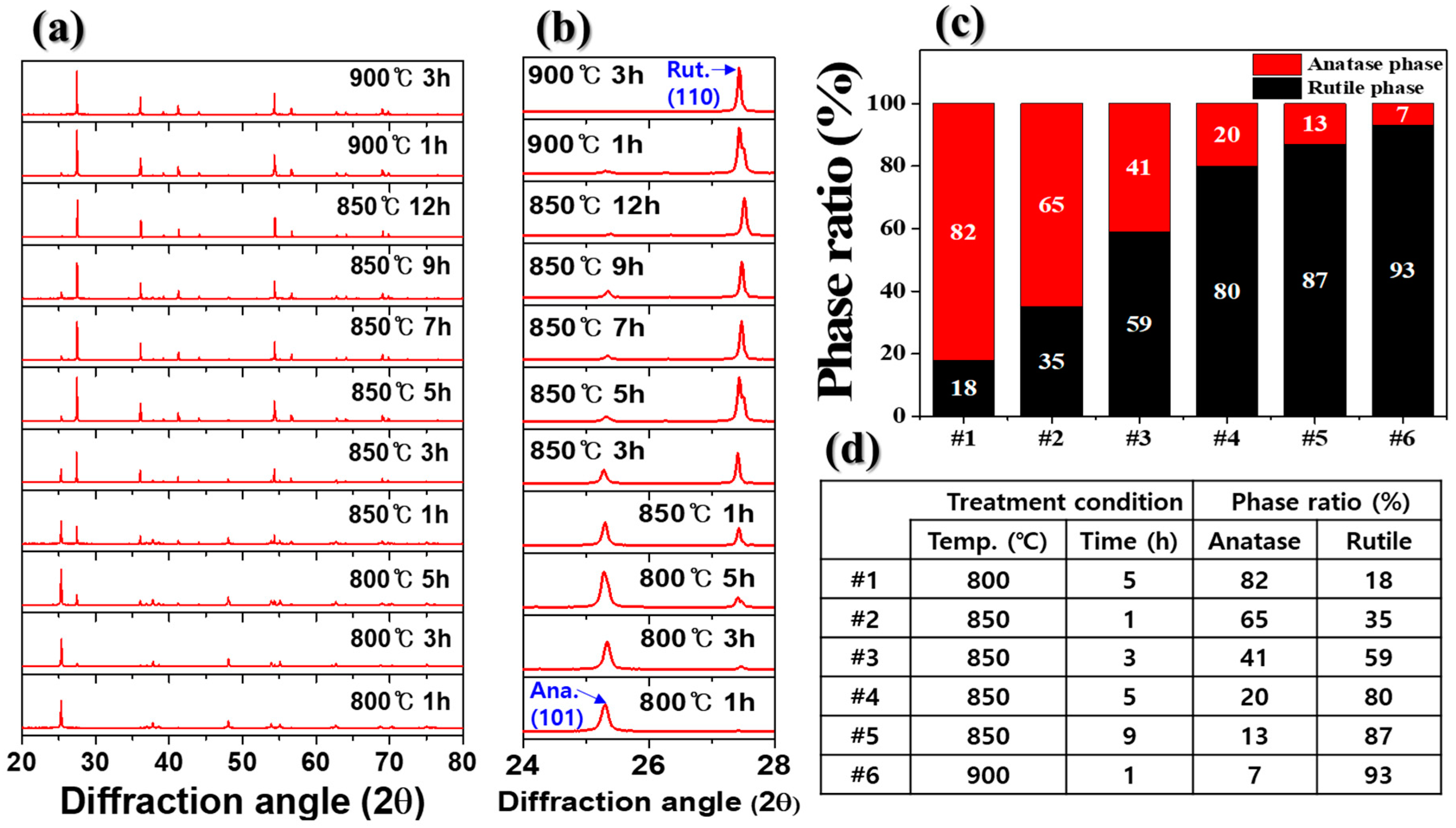
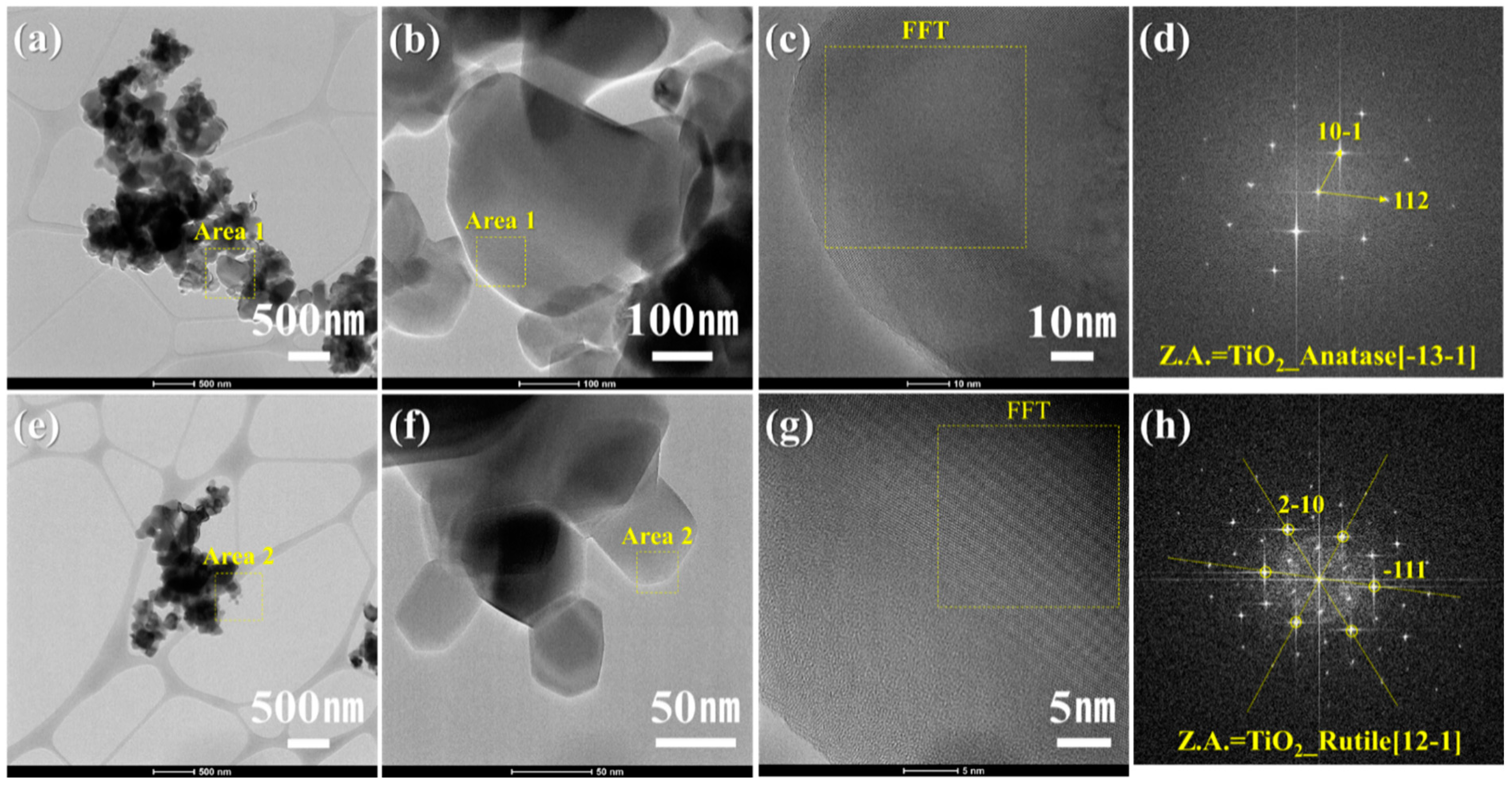
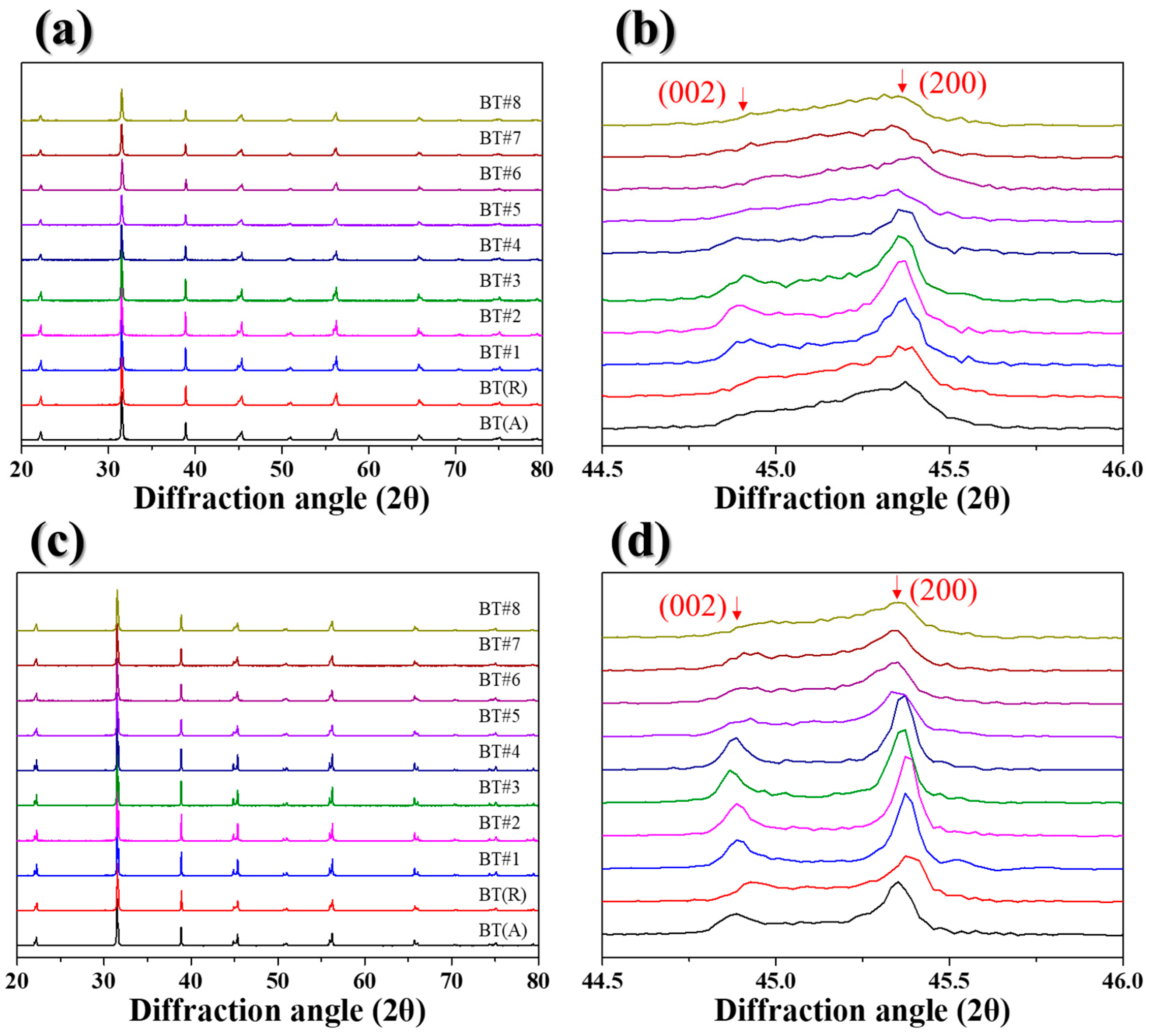
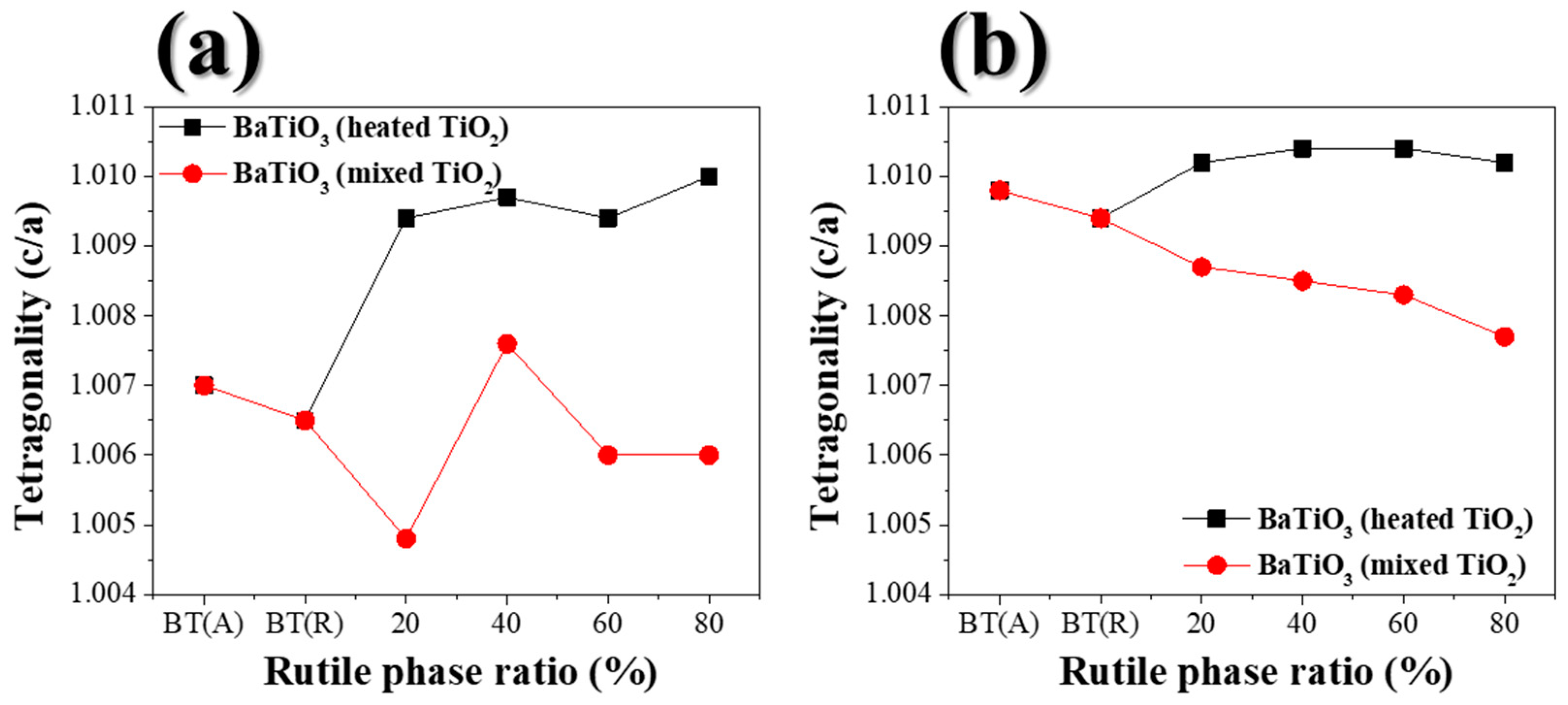
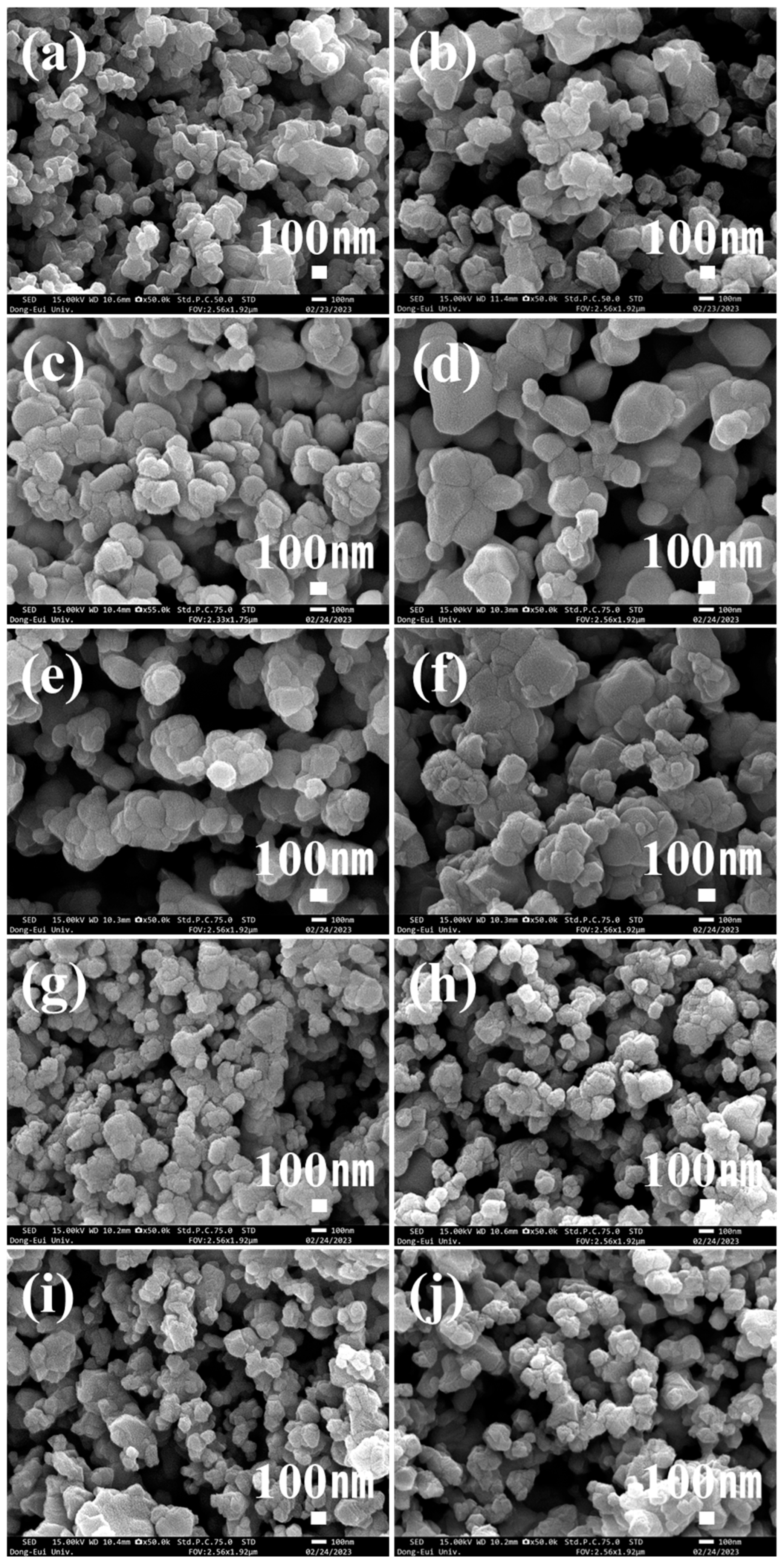
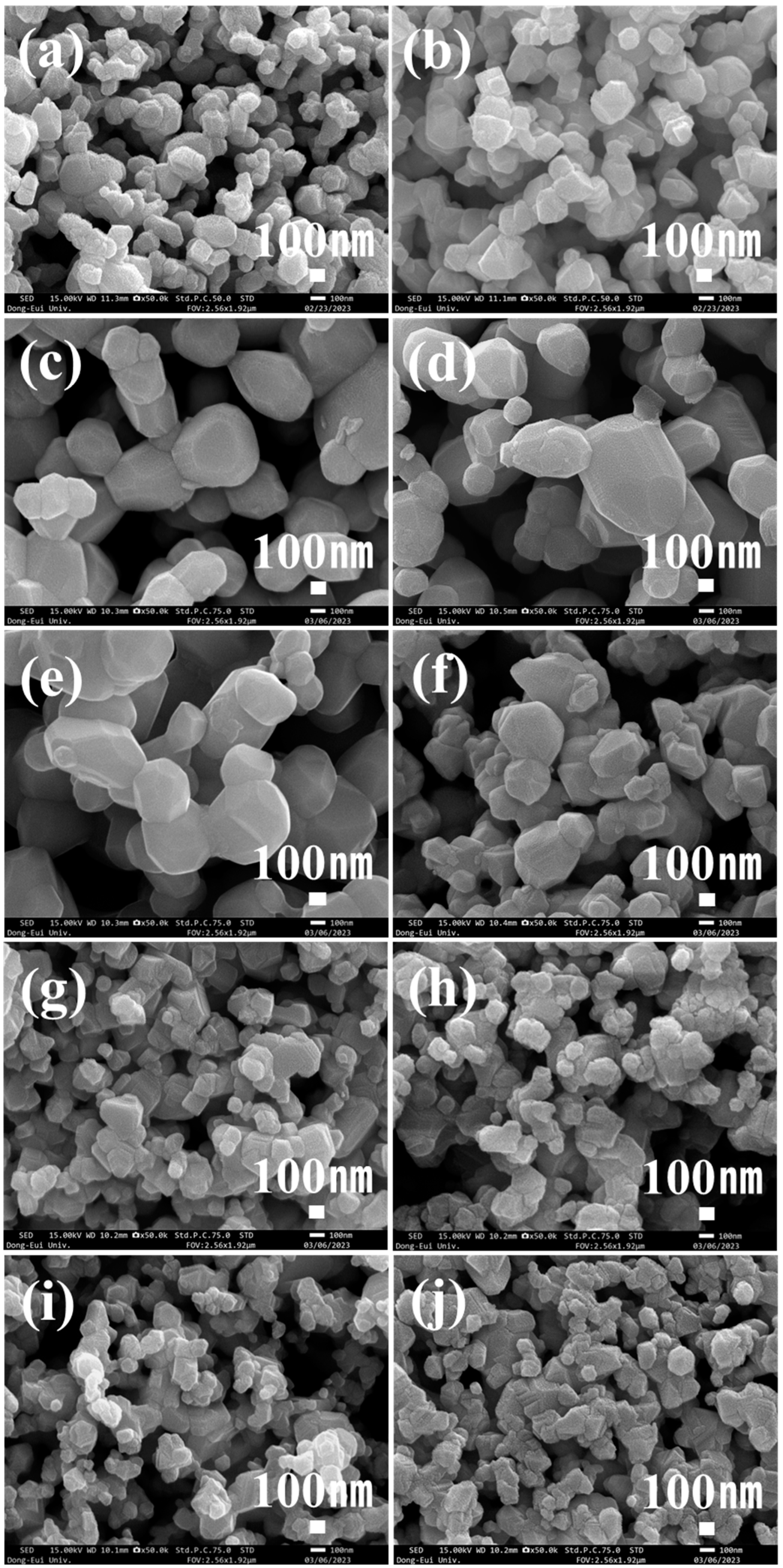

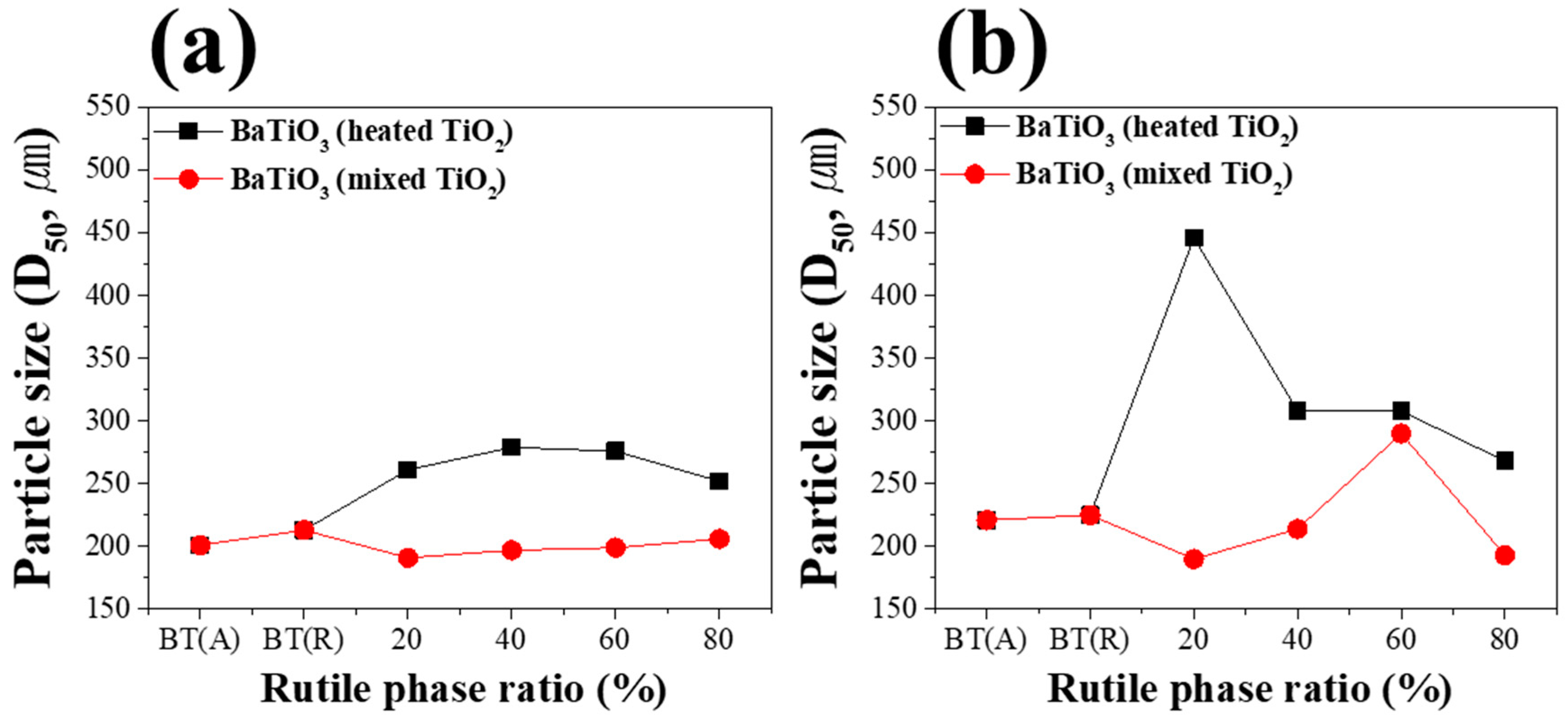
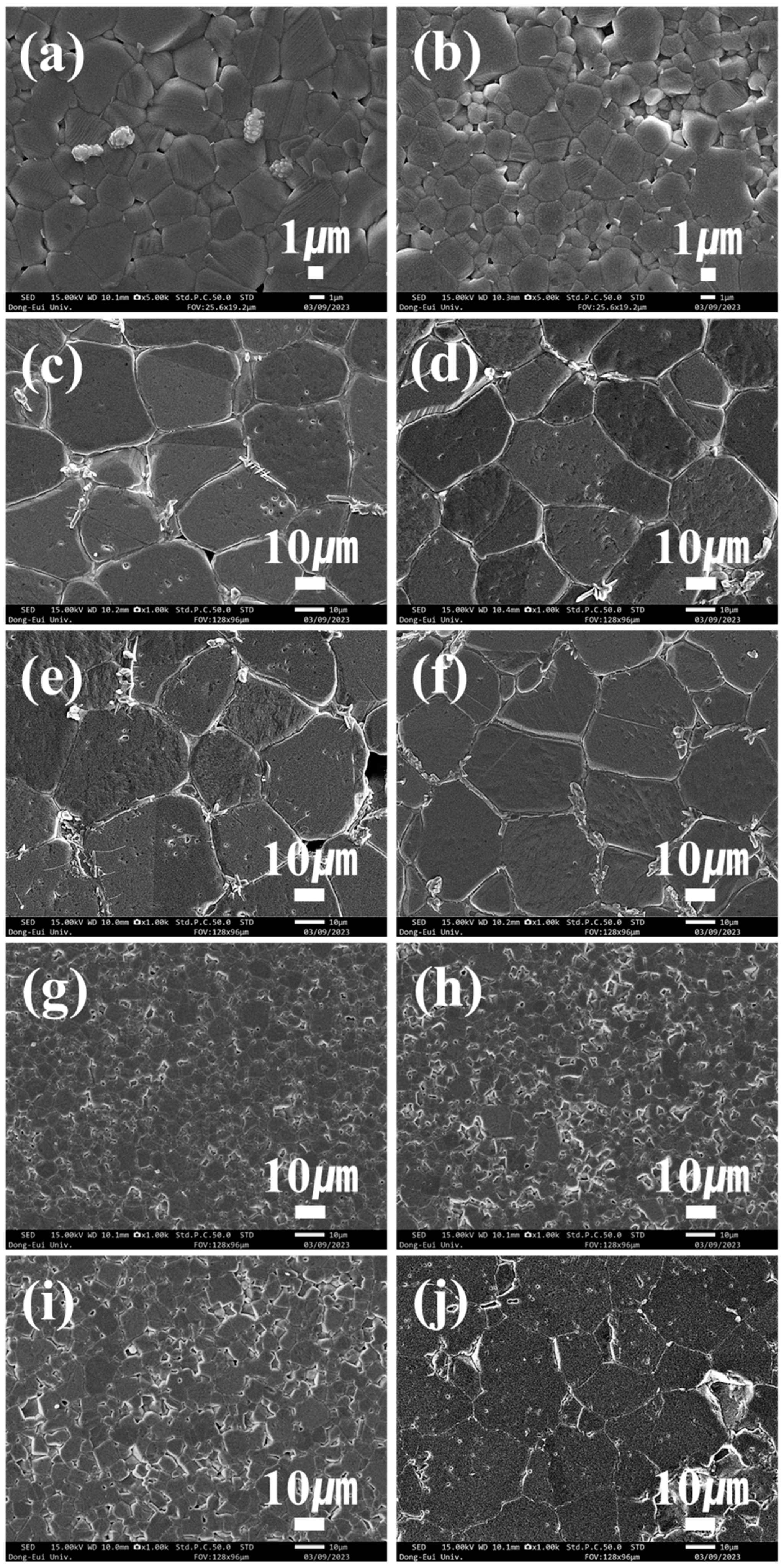
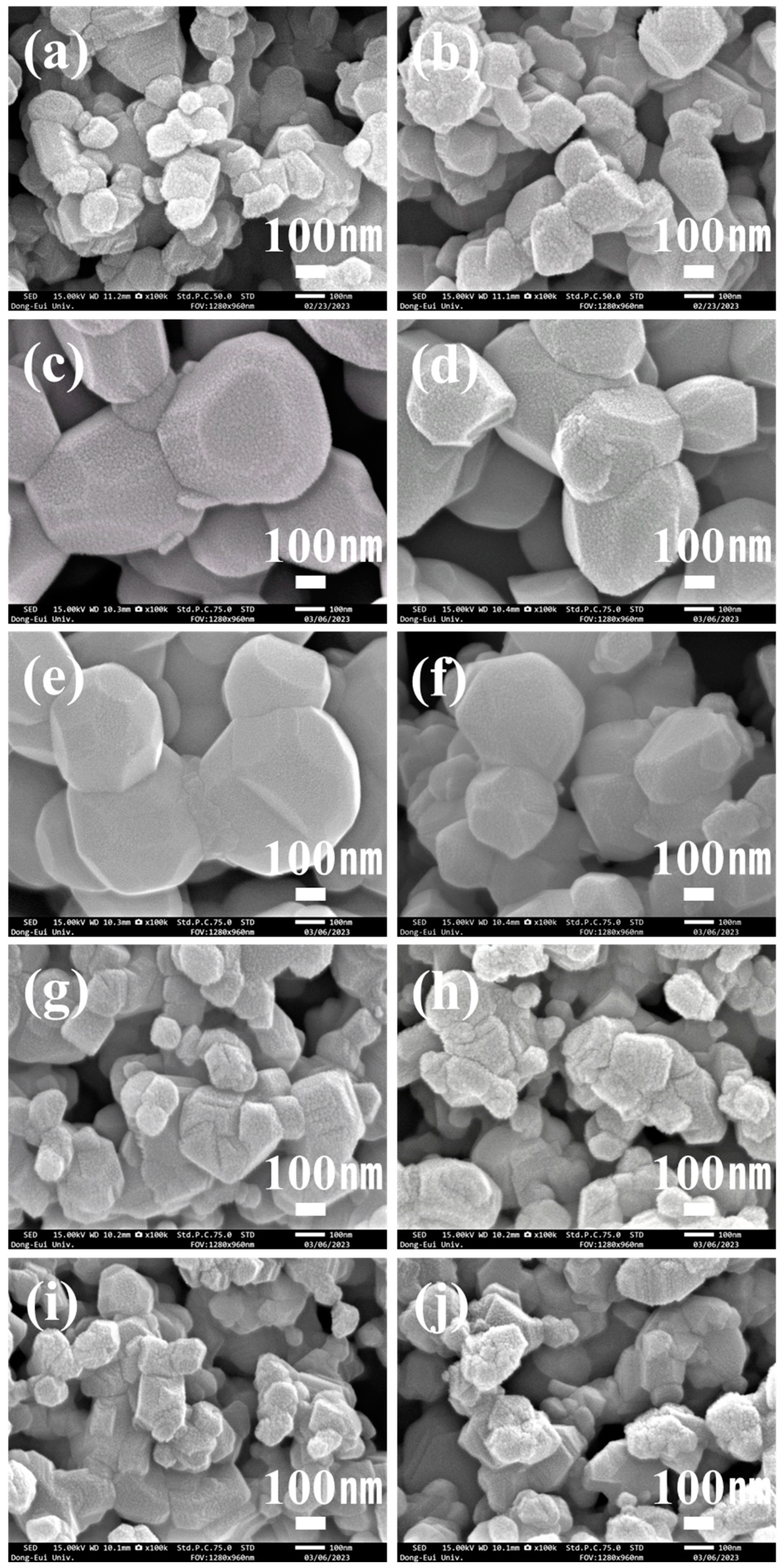
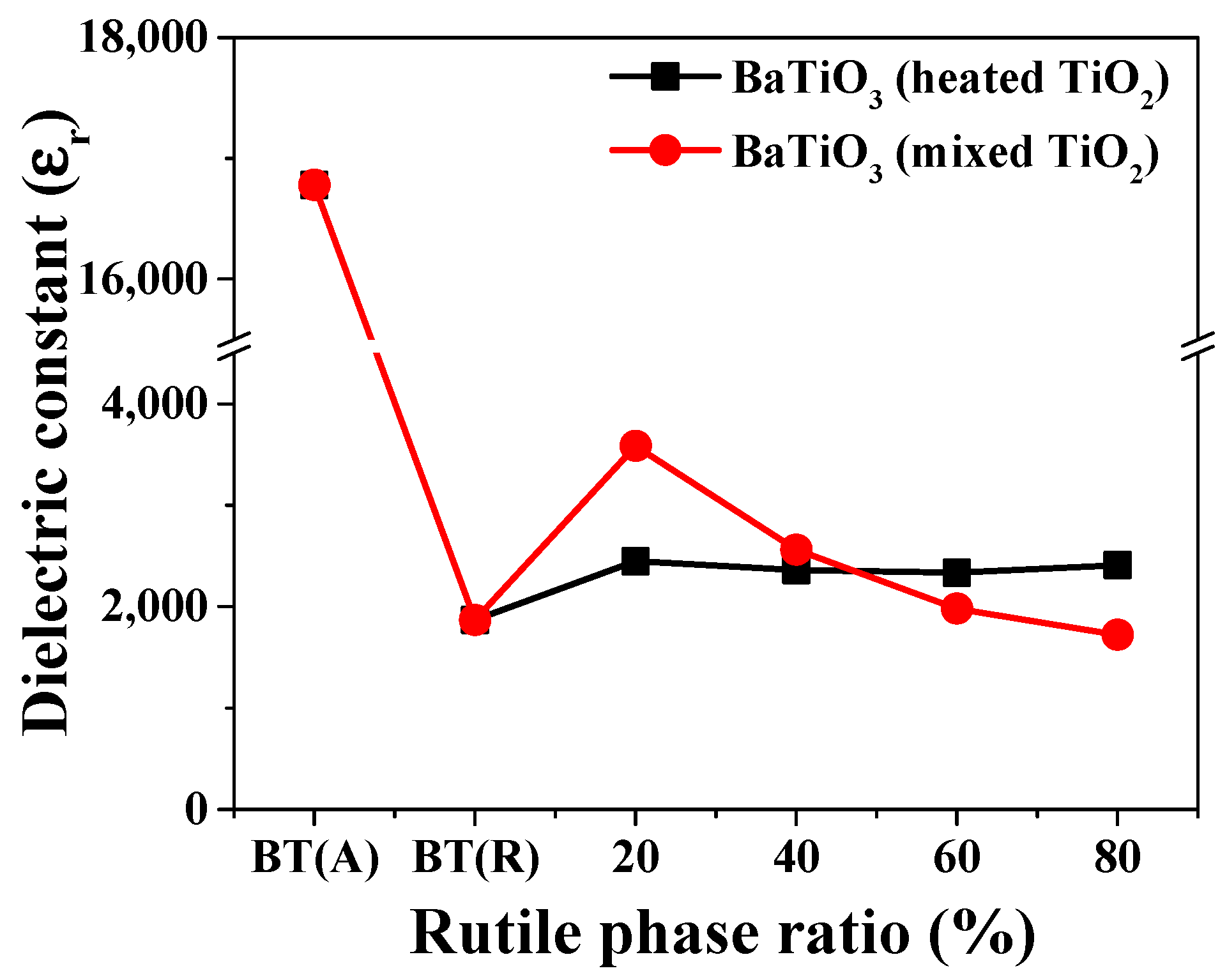
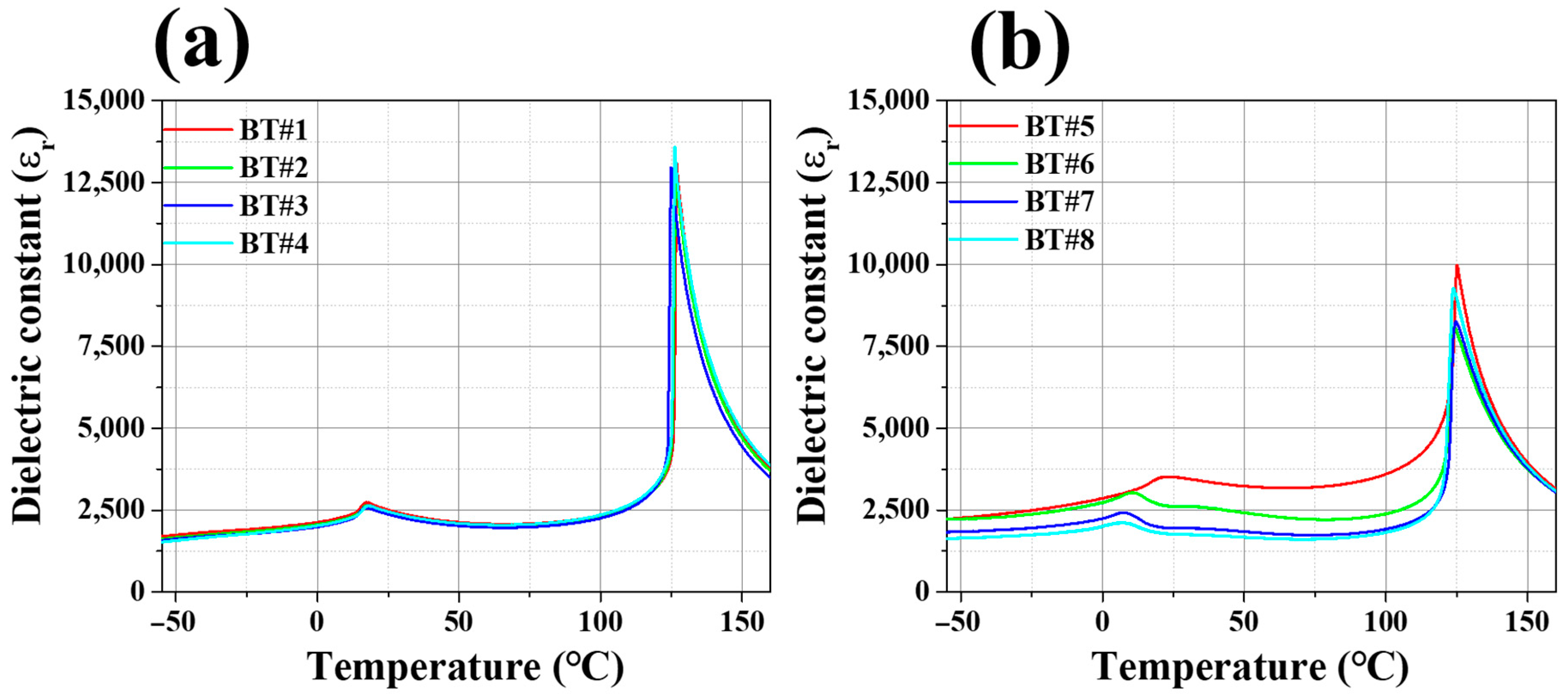
| TiO2 | ||
|---|---|---|
| Heated TiO2 | BT#1 | #1 |
| BT#2 | #2 | |
| BT#3 | #3 | |
| BT#4 | #5 | |
| Mixed TiO2 | BT#5 | A:R = 82:18 |
| BT#6 | A:R = 65:35 | |
| BT#7 | A:R = 41:59 | |
| BT#8 | A:R = 13:87 | |
| Ref. | BT(A) | Anatase TiO2 |
| BT(R) | Rutile TiO2 |
| BaTiO3 Condition | 1000 °C Calcination | 1100 °C Calcination | ||
|---|---|---|---|---|
| Tetragonality (c/a) | Permittivity (εr) | Tetragonality (c/a) | Permittivity (εr) | |
| BT#1 | 1.0094 | 2195 | 1.0102 | 2446 |
| BT#2 | 1.0097 | 2162 | 1.0104 | 2357 |
| BT#3 | 1.0094 | 2093 | 1.0104 | 2334 |
| BT#4 | 1.0100 | 2129 | 1.0102 | 2408 |
| BT#5 | 1.0048 | 3494 | 1.0087 | 3584 |
| BT#6 | 1.0076 | 2380 | 1.0085 | 2561 |
| BT#7 | 1.0060 | 1993 | 1.0083 | 1980 |
| BT#8 | 1.0060 | 1891 | 1.0077 | 1721 |
| BT(A) | 1.0070 | 4042 | 1.0098 | 16,780 |
| BT(R) | 1.0065 | 1782 | 1.0094 | 1867 |
Disclaimer/Publisher’s Note: The statements, opinions and data contained in all publications are solely those of the individual author(s) and contributor(s) and not of MDPI and/or the editor(s). MDPI and/or the editor(s) disclaim responsibility for any injury to people or property resulting from any ideas, methods, instructions or products referred to in the content. |
© 2023 by the authors. Licensee MDPI, Basel, Switzerland. This article is an open access article distributed under the terms and conditions of the Creative Commons Attribution (CC BY) license (https://creativecommons.org/licenses/by/4.0/).
Share and Cite
Lee, S.-H.; Lee, Y.-S.; Kim, J.; Seo, J.-H.; Cho, M.; Kwak, H.; Cheon, R.-S.; Cho, S.; Kim, Y.; Moon, K.-S.; et al. Controlling Composite TiO2 Powder Characteristics in the Solid-State Synthesis of BaTiO3 Powders for Improved Sintering and Permittivity: A Comparative Study. Appl. Sci. 2023, 13, 9720. https://doi.org/10.3390/app13179720
Lee S-H, Lee Y-S, Kim J, Seo J-H, Cho M, Kwak H, Cheon R-S, Cho S, Kim Y, Moon K-S, et al. Controlling Composite TiO2 Powder Characteristics in the Solid-State Synthesis of BaTiO3 Powders for Improved Sintering and Permittivity: A Comparative Study. Applied Sciences. 2023; 13(17):9720. https://doi.org/10.3390/app13179720
Chicago/Turabian StyleLee, Sang-Heun, Yoon-Seok Lee, Jandi Kim, Ji-Hye Seo, Myunghee Cho, Hun Kwak, Ran-Sae Cheon, Seungchan Cho, Yangdo Kim, Kyoung-Seok Moon, and et al. 2023. "Controlling Composite TiO2 Powder Characteristics in the Solid-State Synthesis of BaTiO3 Powders for Improved Sintering and Permittivity: A Comparative Study" Applied Sciences 13, no. 17: 9720. https://doi.org/10.3390/app13179720
APA StyleLee, S.-H., Lee, Y.-S., Kim, J., Seo, J.-H., Cho, M., Kwak, H., Cheon, R.-S., Cho, S., Kim, Y., Moon, K.-S., & Choi, M. (2023). Controlling Composite TiO2 Powder Characteristics in the Solid-State Synthesis of BaTiO3 Powders for Improved Sintering and Permittivity: A Comparative Study. Applied Sciences, 13(17), 9720. https://doi.org/10.3390/app13179720







